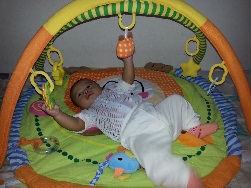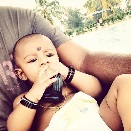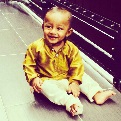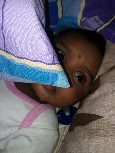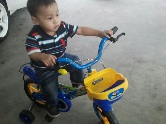What is Normal Development?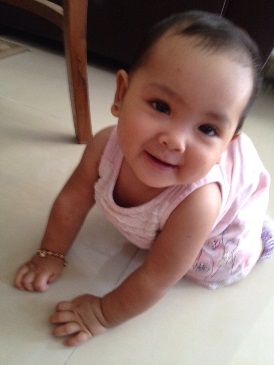
Child development is a dynamic process shaped by a complex interplay between genetic and environmental factors. Development is the acquisition of skills and abilities in a progressive manner as the child grows. Normal development means that a child will be expected to acquire certain skills encompassing his or her gross motor, fine motor, speech and language, cognitive and social skills at an expected age. There is enormous variation in both the rate and the pattern of normal development.
When should I be worried?
A child is expected to attain a certain skill at a particular age and this is called developmental milestone. The sequences of development are similar in most children and the developmental milestones are useful markers to observe the rate of development. If a child does not acquire these skills in a timely fashion, there is a possibility that he or she has developmental delay. Delay in any developmental sequence, plateauing or regression of development requires an early referral to the doctor for further assessment. The following developmental milestones and warning signs are a guide to delay at varying ages that may assist to identify children requiring intervention early.
|
Developmental Milestones and Warning Signs |
|||||
|
Age |
Gross Motor |
Fine Motor |
Speech/ Language |
Social |
Warning Signs |
| 6 weeks |
Head in midline without the head turning to one side consistently. Little or no head lag when pulled to sitting position
|
Fixates and follows past Hands often open |
Vocalizes when pleased (coo) Quietens to sound Startles to sound |
Spontaneous smile |
Does not fix on mother’s face
|
| 3 months |
Holds up head and upper chest on forearms, with buttocks flat |
Hand regard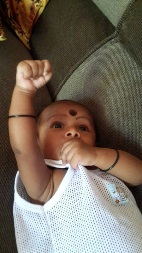 Follows object from side to side (180o) 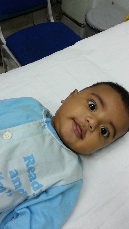 Grasps objects placed in hand |
Laughs, chuckles Turns head to sound |
Show pleasure by laughing or looking excited when the baby is picked up and cuddled or his/her hair is stroked
|
Little interest in people, noise Fisting of hands No smile or vocalising |
|
6 months |
Lifts head in anticipation when pulled to sit
|
Reaching out Palmar grasp |
Babbles (monosyllabic) |
Puts objects into mouth Responds to social games such as peek-a-boo and shows anticipation Becoming stanger aware (reacting by withdrawing or crying) |
Persistent squint Hand preference Not reaching for a toy placed in front of them Not looking at people talking |
| 9 months |
Crawl Sit n crawl 2 (Video) Sit steadily |
Transfer objects Bang 2 cubes Exploration with index finger Object permanence |
Locates sound above and below the ear ‘word like” sounds with intonation (jargon) |
Looks for fallen toy Waves bye-bye Plays peek-a-boo Holds, bites and chews finger food |
No double Does not look at objects Persistence of hand regard Lack of interest in social games |
| 18 months |
Walk steadily and stop safely Run steadily but unable to avoid obstacles Climb up stairs with hand-held and 2 feet per step |
Able to build a tower of 3-4 Imitates stroke |
1- 6 words Points to 2-3 body parts when asked |
Imitates household activities Holds spoon and gets food safely to mouth |
Not walking No clear Not defining objects by their use No joint attention |
|
2 years |
Run safely avoiding obstacles Walk up and down stairs, 2 feet per step, holding on rail Throw a ball
|
Able to build a tower of 6 cubes Circular scribble Able to imitate vertical line |
50+ words Put 2 words together Obeys simple commands Able to name Understands preposition eg in,on |
Eats with spoon skilfully Puts on shoes, pants Dry by day Plays near |
No phrased speech (2 words) Absence of simple pretend play |
|
3 years |
Pedal tricycle Walks upstairs, one foot per step, and downstairs, two feet per step Hops on one foot for 3 steps (each foot) Throw a ball overhead |
Able to build a tower of 9 cubes Copies circle and imitates + |
Put 3- 4 words together Name 2 colours Able to sing nursery rhymes Understands preposition eg under, in front of/ behind |
Eats with fork and spoon Dresses and undresses with help Dry by night Plays with others |
Does not Not routinely using two to three word sentences |
|
4 years |
Stand on one foot for about 6 secs Walks upstairs and downstairs, adult manner Rides tricycle and make sharp turns easily |
Draws a person with 3 parts Copies + |
Sentences of 5+ words Uses conjunctions (and, but) Names 4 colours |
Wash and dry hands Imaginative play |
Not understanding ‘what’ and ‘why’ questions Unable to use sentences |
|
5 years |
Stands on one foot for 10 secs Runs on toes Skips on both feet Bends at waist and touch his/her toes |
Copies Draws person with 6 parts |
Fluent speech Present a picture depicting multiple activities and ask ‘look at the picture and tell me what is happening” (describing narrative) |
Understands rules of play Dresses and |
|
Where should I seek help?
If your child does not achieve the developmental milestones at the expected age or displays warning signs, please seek medical attention from your healthcare provider at the nearest health clinic or hospital with paediatric services.
| Last Reviewed | : | 28 August 2020 |
| Writer | : | Dr. Aina Mariana bt. Abdul Manaf |
| Accreditor | : | Dr. Ranjini S. Sivanesom |
| Reviewer | : | Dr. Zainab bt. Kusiar |


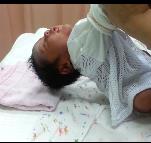


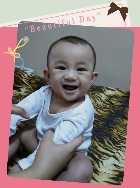
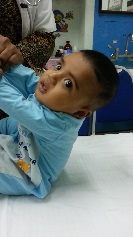 Supports weight on
Supports weight on 

